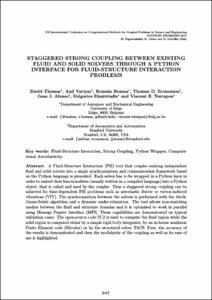Staggered strong coupling between existing fluid and solid solvers through a python interface for fluid-structure interaction problems

Visualitza/Obre
Estadístiques de LA Referencia / Recolecta
Inclou dades d'ús des de 2022
Cita com:
hdl:2117/190653
Tipus de documentText en actes de congrés
Data publicació2017
EditorCIMNE
Condicions d'accésAccés obert
Tots els drets reservats. Aquesta obra està protegida pels drets de propietat intel·lectual i
industrial corresponents. Sense perjudici de les exempcions legals existents, queda prohibida la seva
reproducció, distribució, comunicació pública o transformació sense l'autorització del titular dels drets
Abstract
A Fluid-Structure Interaction (FSI) tool that couples existing independent
fluid and solid solvers into a single synchronization and communication framework based on the
Python language is presented. Each solver has to be wrapped in a Python layer in order to embed
their functionalities (usually written in a compiled language) into a Python object, that is called
and used by the coupler. Thus a staggered strong coupling can be achieved for time-dependent
FSI problems such as aeroelastic flutter or vortex-induced vibrations (VIV). The
synchronization between the solvers is performed with the block- Gauss-Seidel algorithm and a
dynamic under-relaxation. The tool allows non-matching meshes between the fluid and
structure domains and it is optimised to work in parallel using Message Passive
Interface (MPI). These capabilities are demonstrated on typical validation cases. The
open-source code SU2 is used to compute the fluid region while the solid region is computed either
by a simple rigid body integrator, by an in-house nonlinear Finite Element code (Metafor) or
by the structural solver TACS. First, the accuracy of the results is demonstrated and then
the modularity of the coupling as well as its ease of
use is highlighted.
ISBN978-84-946909-2-1
| Fitxers | Descripció | Mida | Format | Visualitza |
|---|---|---|---|---|
| Coupled-2017-59-Staggered strong couling.pdf | 572,4Kb | Visualitza/Obre |

